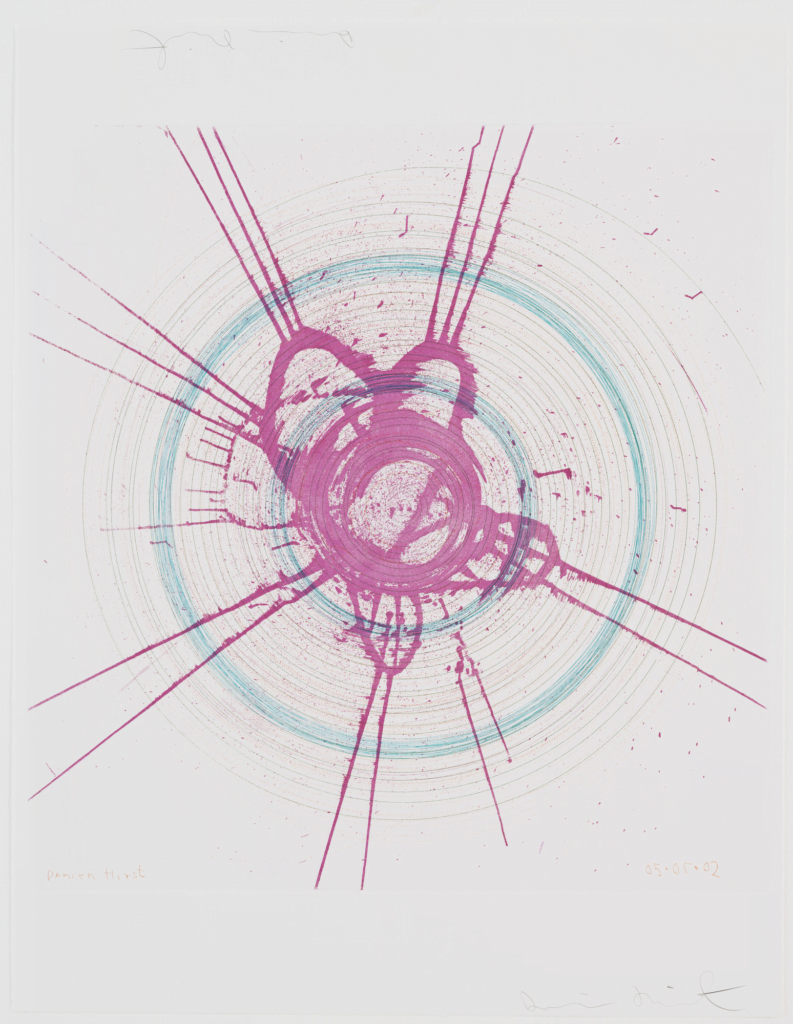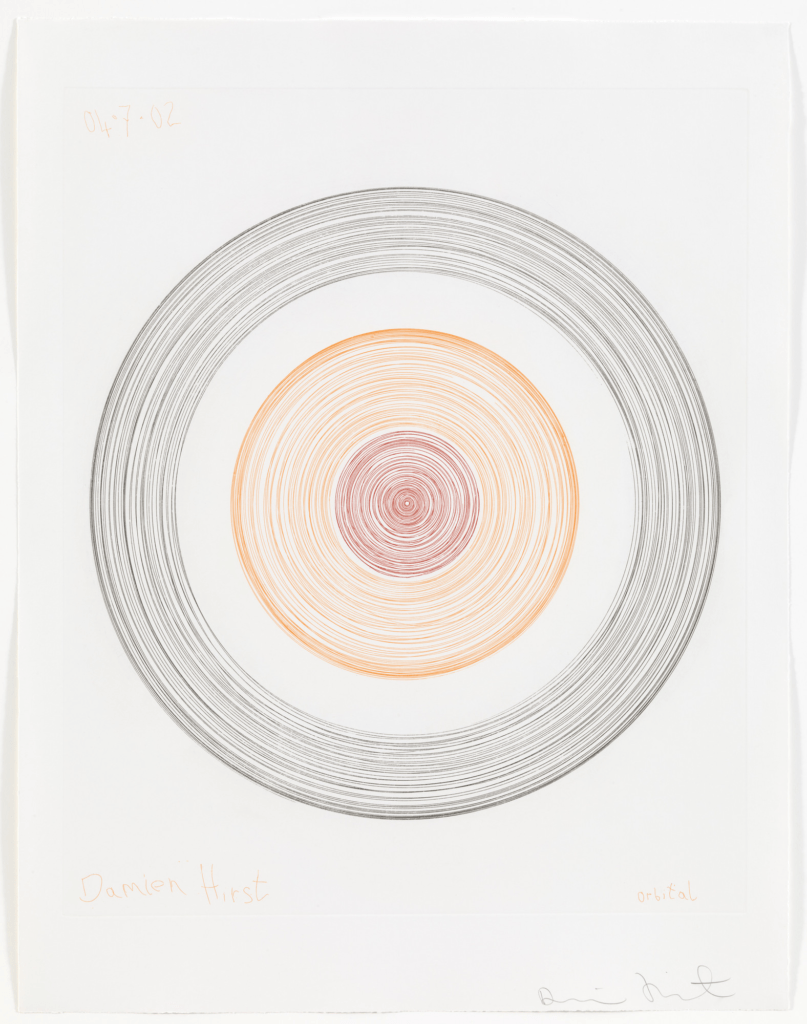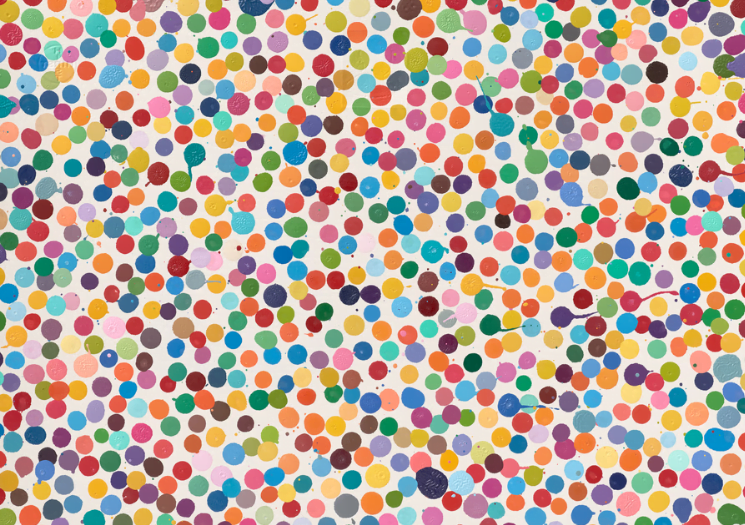Memoriesforart » Artists » Damien Hirst

More Facts
Name: Damien
Surname: Hirst
Gender: Male
Lives & Works: Bristol
Lives in State: Bristol
Nationality: England
Date of Birth: 1965
Period: Post-War
Movement: Contemporary, Young British Artists
Table of Contents

Damien Steven Hirst was born Damien Steven Brennan in Bristol, United Kingdom. He grew up in Leeds with his mother, who worked for the Citizens Advice Bureau. Hirst never met his father, as his mother married his stepfather when he was two years old, and the couple later divorced. His stepfather was reportedly a motor mechanic.
During his early years, Hirst’s mother had difficulty controlling him, and he got into trouble, being arrested twice for shoplifting. However, she encouraged his interest in drawing, which became his only successful educational subject.
In school, Hirst’s art teacher at Allerton Grange School advocated for him to enter the sixth form, where he took two A-levels, achieving an “E” grade in art. Initially, he was denied admission to Jacob Kramer College, but he eventually attended the art school after being accepted into the Foundation Diploma course.
Hirst’s artistic inspiration came in 1983 when he attended an exhibition of work by Francis Davison, curated by Julian Spalding, at the Hayward Gallery. Davison’s abstract collages made from torn and cut colored paper profoundly influenced Hirst, who based his own work on this style for the next two years.
After spending two years working on building sites in London, Hirst pursued his passion for art by studying Fine Art at Goldsmiths College from 1986 to 1989. However, he faced initial rejection when he first applied to the college.
During his time at Goldsmiths, Hirst had a pivotal encounter with the artwork “An Oak Tree” by Goldsmiths’ senior tutor, Michael Craig-Martin, which he considered to be the greatest piece of conceptual sculpture and a work that continued to resonate with him.
While still a student, Hirst had an influential placement at a mortuary, an experience that would later shape the themes and materials he incorporated into his art. Additionally, as an art student, Hirst worked as an assistant at Anthony d’Offay’s gallery, further immersing himself in the world of art and gallery practices.

Damien Steven Hirst is a prominent British artist known for his provocative and controversial artworks that challenge the boundaries of contemporary art.

Hirst’s artworks have often sparked controversy and divided opinions. Critics argue that his reliance on shock value and commercialism overshadows the artistic merit of his creations.
Positive:
Negative:
Damien Hirst’s innovative and boundary-pushing approach to art has profoundly influenced the contemporary art landscape.
His conceptual ideas, use of unconventional materials, and exploration of provocative themes have inspired countless artists to push the limits of their creativity.

Damien Hirst’s artistic approach is characterized by various mediums and styles, often exploring themes of life, death, mortality, and the fragility of existence. His works challenge conventional notions of art and blur the boundaries between art, science, and popular culture.
Damien Hirst gained early recognition with the groundbreaking exhibition “Freeze” held at Surrey Docks in London. As a key figure in the Young British Artists (YBAs) movement, Hirst curated this show, showcasing his work and that of his contemporaries.
It marked a turning point in the contemporary art scene and set the stage for Hirst’s future success.
One of Hirst’s most iconic and controversial works, this installation features a preserved tiger shark suspended in a vitrine filled with formaldehyde.
The piece explores themes of mortality, decay, and the fragility of life. It gained international attention and solidified Hirst’s reputation as an artist pushing boundaries and challenging the traditional notions of art.
Presented at the Venice Biennale, this thought-provoking artwork consists of a cow and a calf, each cut into sections and displayed in separate vitrines. It explores the concept of physical and emotional division and raises questions about the human-animal relationship.
The piece showcases Hirst’s ability to evoke strong reactions and engage viewers in a dialogue about art and its meaning.
This stunning and controversial artwork captures the public’s attention with its audaciousness. For the Love of God is a human skull cast in platinum and encrusted with over 8,000 diamonds.
It confronts themes of mortality, wealth, and the value of life, challenging the viewer’s perception of art and its relationship to commercialism.
Hirst’s spot paintings, created over several decades, are characterized by meticulously arranged rows of colorful dots. These paintings explore the concepts of pattern, repetition, and the artist’s role in the production of art. The spot paintings became integral to Hirst’s artistic identity and exemplified his interest in blurring the boundaries between art and mass production.
This groundbreaking auction marked a significant departure from traditional art sales. Hirst bypassed galleries and sold his work directly to the public at Sotheby’s, London. The auction raised an astonishing £111 million ($198 million) and cemented Hirst’s position as one of the most commercially successful artists of his time. It challenged the conventional art market and sparked debates about the relationship between art and commerce.
In this ambitious exhibition held in Venice, Hirst created a fantastical narrative involving a fictional shipwreck and a collection of ancient artifacts. Blurring the lines between truth and fiction, Hirst challenged the notions of authenticity and the role of storytelling in art. The exhibition showcased Hirst’s ability to captivate audiences with grand-scale installations and elaborate narratives.
Hirst’s collection of artworks is housed in the Newport Street Gallery in London. The gallery, designed by architects Peter St John and Adam Caruso, allows Hirst to share his love of art with the public. The gallery reflects Hirst’s commitment to promoting and supporting contemporary art.
Damien Hirst’s notable works demonstrate his ability to provoke, challenge, and captivate audiences. From controversial installations to thought-provoking exhibitions, Hirst has left an indelible mark on the art world.
Titel: Lullaby Spring 2002

Damien Hirst Takes Bold Action with “The Currency” Artwork
In a daring move that captured the attention of art enthusiasts and NFT aficionados alike, renowned artist Damien Hirst embarked on a groundbreaking project called “The Currency.” Launched in collaboration with tech company HENI in July 2021, the project comprised a collection of 10,000 NFTs, each corresponding to a unique physical artwork meticulously crafted by Hirst himself.
The Creation of “The Currency”:
Hirst began crafting the physical artworks in 2016, using enamel paint to create one-of-a-kind pieces that carried his distinctive style. Every artwork was individually numbered, titled, stamped, and signed by the artist, boasting additional authenticity features like watermarks, microdots, and holograms. No two pieces shared the same color, as Hirst passionately devoted his efforts to handcrafting each artwork with utmost care and attention to detail. The titles of these masterpieces were generated using machine learning, embedding some of the artist’s favorite song lyrics onto the paper, adding a unique touch to every creation.
The NFT Transformation and Choice of Ownership:
With the advent of NFT technology, Hirst saw an opportunity to explore the intersection of art and currency, sparking curiosity about the nature of ownership and collecting. As the project took shape, collectors found themselves facing a fascinating dilemma. They were presented with the option of owning either the NFT or the physical artwork, but not both. They had to make a choice under a specified deadline.
The “Burn Event” and Art’s Transformative Journey:
To reinforce the notion of exclusivity and rarity, Hirst boldly declared that if a collector chose to own the NFT counterpart of an artwork, he would physically burn the corresponding physical piece. The first 1,000 physical artworks met their fiery fate at Newport Street Gallery on October 12th, 2022, as Hirst, wearing fire-resistant gloves, solemnly consigned them to the flames. The spectacle drew crowds of buyers and onlookers who witnessed the convergence of art and technology in a state-of-the-art-looking fireplace.
Hirst’s Clarity on Intent:
Ahead of the “Burn Event,” Hirst took to Instagram to clarify his intentions. He emphasized that he was not destroying millions of dollars of his public art, as some had misconstrued. Rather, his act was a symbolic transformation of the physical artworks into NFTs, where the value of art—whether digital or physical—would be preserved and transferred to the NFTs. The burning of his own artworks and the remaining physical copies continued daily until the show’s conclusion on October 30th, 2022. Newport Street Gallery warmly invited visitors to witness the exhibition and the artworks’ gradual transformation into the digital realm during specific hours each week.
Internet Reactions and the Essence of “The Currency”:
As the burning spectacle unfolded, online communities reacted with a mix of opinions. Some questioned Hirst’s understanding of NFTs and digital art, while others remarked on the inherent relationship between art and money. Climate change concerns also found their way into the discourse, given the carbon footprint of such a project. Amid the diverse comments, the essence of “The Currency” remained clear—a bold exploration of the ever-evolving landscape of art, ownership, and the fusion of digital and physical worlds.
“The Currency” marked a significant milestone in Damien Hirst’s artistic journey, pushing the boundaries of creativity and challenging conventional notions of art’s value. With its blend of artistic mastery and technological innovation, the project will undoubtedly be remembered as a transformative moment in contemporary art history, inspiring future generations to ponder the multifaceted nature of creativity and its place in an increasingly digitized world.



Instagram: https://www.instagram.com/damienhirst/?hl=en
Facebook: https://www.facebook.com/profile.php?id=100050604364160
Twitter: https://twitter.com/hirst_official?lang=en
For a comprehensive look at Damien Hirst’s artworks, exhibitions, and recent updates, visit his official website.